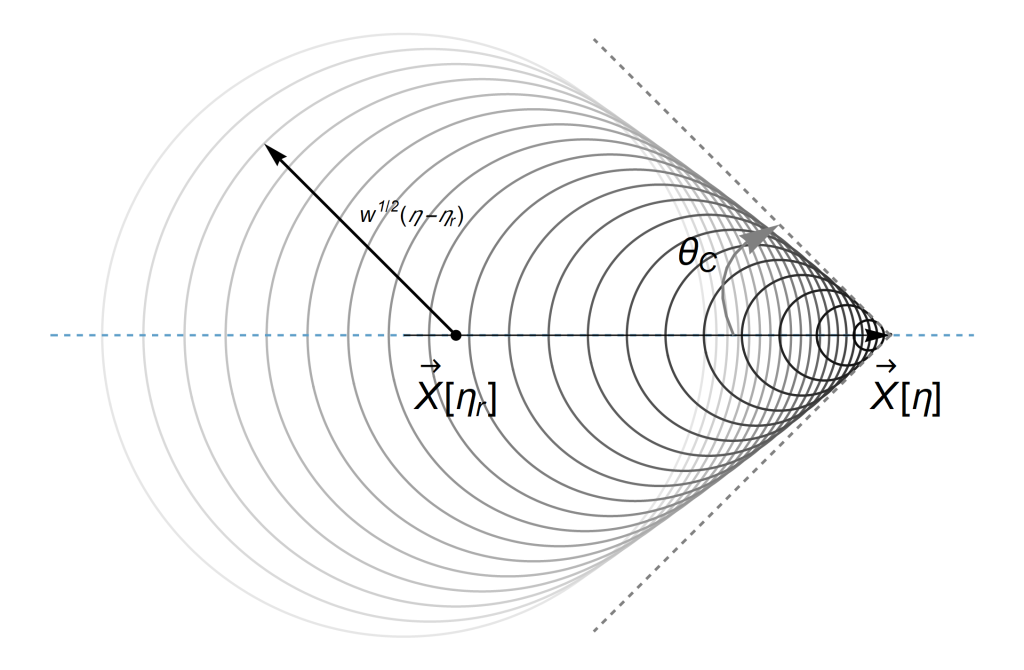Yen-Wei Liu and I have been trying to understand whether the Bardeen gauge-invariant scalar metric perturbations in cosmological backgrounds ought to be understood as gravitational radiation — wave solutions capable of carrying energy-momentum to infinity, arising from the scalar sectors of Einstein’s equations linearized about a radiation dominated universe, in particular. Thus far, we have gathered the following observations pointing to the answer being in the affirmative.
- The Bardeen scalars obey a wave equation with respect to a modified ‘cosmological metric’ with acoustic speed
, after their equations-of-motion are decoupled from the vector and tensor ones. This result is well-known, and can be found in Chapter 7 of Mukhanov’s cosmology text. What appears less understood is whether the corresponding solutions are to be interpreted as radiation.
- To this end, in arXiv: 2001.06695, Yen-Wei and I first computed the gauge-invariant linearized Weyl tensor in a radiation-dominated universe, using the homogeneous solutions of the Bardeen scalars, and found a non-trivial result. Since the Weyl tensor encodes the ‘trace-less’ portion of the physical tidal forces induced by spacetime curvature, this indicates Bardeen scalars not only can propagate freely but are capable of squeezing and stretching — i.e., doing work upon — material objects immersed in such a cosmological geometry.
- In the same arXiv: 2001.06695, Yen-Wei and I also computed the Bardeen scalars’ contribution to the linearized Weyl tensor sourced by some hypothetical astrophysical source. As expected on physical grounds, in the far zone, the form of this inhomogeneous solution approaches that of the homogeneous solutions — outgoing spherical waves become, approximately, plane waves. This, in turn, allowed us to not only further corroborate this Bardeen-scalars-can-do-work interpretation; we were able to extract the corresponding polarization and oscillatory (spin-0-like) patterns in the short-wavelength limit.



Rightmost panel: Scalar gravitational wave polarization pattern in a radiation dominated universe.
That the Bardeen scalars obey a wave equation with acoustic speed suggests that — if they can be indeed regarded as gravitational radiation — Cherenkov gravitational radiation is possible in the radiation era of our universe. This prompted our more recent work in arXiv: 2108.13463.

Figure from arXiv: 2108.13463.
In electromagnetism, Cherenkov radiation occurs in a medium whenever an electrically charged particle is moving faster than the medium’s effective speed of light. The electromagnetic signal’s wave front cannot outrun the charged particle. Hence, a shockwave forms because the electromagnetic fields are strictly zero outside of it.
What Yen-Wei and I argued was that an analogous situation occurs whenever primordial black holes or cosmic strings — if they exist! — moves through the photon’s relativistic fluid at speeds greater than . Specifically, we computed the Bardeen scalars’ contribution to the linearized Weyl tensor for a point mass and an infinitely straight Nambu-Goto wire moving along a supersonic geodesic, and derived the shape and strength of their Cherenkov shockwave. Near the Cherenkov cone or wedge with unit normal
, we argued that tidal forces acting on a pair of free falling test masses oriented along
would be proportional to
. Furthermore, for the supersonic point mass, this tidal force would blow up as
. Once again, that such a Cherenkov shock front can exert geometry-induced work indicates Bardeen scalars constitute gravitational radiation.
I pose a question for future work:
If primordial black holes or cosmic strings exist, and if they end up moving faster than
during the radiation era, are there signatures of this Cherenkov gravitational radiation that are still observable at our current epoch?
Update, 31 March 2022: I added an exaggerated visualization of the gravitational wave polarization patterns.

I was brought here by an article about you in “The College Fix”. Congratulations Dr. Chu.
LikeLike
Thank you, Bill! I hope more will join this fight for meritocracy, reason, and science.
LikeLike